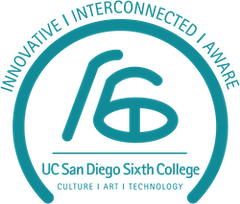CAT 1
CAT 1 courses (four units, fall quarter) teach critical reading and drafting by examining how culture, art, and technology have intersected in the past. Students must have completed the Entry Level Writing Requirement in order to enroll in CAT 1.
Learning Objectives
CAT 1 students work towards these goals:
-
Understand writing as a process that includes brainstorming, drafting, peer review, revision, and reflection.
-
Develop metacognitive and critical reading and thinking skills., including learning the parts of an argument.
-
Learn how to ask constructive questions.
-
Practice writing as a learning strategy in community, in lecture and discussion. Developing the ability to critically read, summarize, and respond to arguments both in writing and in person.
-
Learn how to read critically across a variety of genres and identify disciplinary discourse.
Writing Skills
CAT 1 fosters the following skills:
-
Critical curiosity—active reading and asking productive questions.
-
Summary, including identifying the parts of an argument when applicable.
-
Analysis of a text.
-
Paragraph structure.
-
Reflection and metacognition.
Core Concepts
By the end of CAT 1, students should be able to understand and define the below terms and ideas:
-
Ideology.
-
History as narrative.
-
Production of knowledge: culture, art, and technology.
Common Readings
All CAT 1 students will read these texts:
-
Eugenia Cheng: Unequal, Chapter 1 and Chapter 7.
-
Russell P. Johnson: "On ChatGPT: A Letter to My Students."
-
Meghan O’Rourke: "I Teach Creative Writing. This Is What AI Is Doing to Students."
Fall 2025
CAT 1: A Hollywood History: Filming America from "Boxing Cats" to Jaws
Phoebe Bronstein
Associate Teaching Professor, CAT
Monday/Wednesday/Friday 10:00-10:50 a.m.
Monday/Wednesday/Friday 11:00-11:50 a.m.
This writing and communication course will focus on the history of American film from early one-shot shorts like Edison's Boxing Cats to the first summer blockbuster, Jaws. As film became a mass medium in the early part of the twentieth century, so too did Hollywood shape and react to social and political forces. Understanding the history of Hollywood will help us better understand, critique, and appreciate today's popular culture landscape. Thus, as we learn to read film and read about film history, we will use a close analysis of Hollywood productions to consider topics in American culture from racism to sex (and Hollywood scandals!), violence, and humor. Potential films we will watch include (but are not limited to) Modern Times (1936), Gentlemen Prefer Blondes (1953), and Shaft (1971). As we read across a variety of genres—from films to academic articles and popular press pieces—we will develop critical reading and writing skills that will prepare you for the writing-intensive CAT 2 and to read college-level material across your other courses.
CAT 1: Origins
Guillermo Algaze
Professor, Anthropology
Monday/Wednesday/Friday 10:00-10:50 a.m.
This CAT 1 course focuses on a key question: "How did human beings come to have culture, art, and technology in the first place?" The course is centered on the human capacity for technological innovation and symbolic representation. It presents a global historical overview of the general principles and patterns of past human development, and focuses particular attention on the interrelationships between demographic, cultural, and technological changes in the last 50,000 or so years of the human career.
CAT 1: Twice Upon a Time: Lore, Adaptation, and Identity
Jennifer Marchisotto
Lecturer, CAT
Monday/Wednesday/Friday 1:00-1:50 p.m.
From myths to monsters, fairytales to fables, we tell stories to help make sense of the world around us. Shared lore helps create (and divide) communities, defining identity at both individual and national levels. From ancient civilizations to the Irish Revival movement in the early 1900s to contemporary retellings of African folklore in the work of Marlon James, Tomi Adeyemi, and Ayana Gray, mythology can simultaneously speak to the past, present, and future. In this CAT 1 course, we will embrace a broad definition of lore that encompasses diverse forms of storytelling to look at the ways narrative helps us understand the past and how adaptations of classic myths and tales can shift that understanding, revising and reinventing them for the current moment. We will look at texts from literary criticism as well as a variety of forms of popular culture including film, music, and television to hone our critical thinking and writing skills. We will also engage theories of critical race studies, critical gender studies, and disability studies to inform and enhance our engagement with the texts. Overall, we will consider how storytelling has helped to create history, but also how we can use those same stories to actively reinvent and shift our present moment through adaptation.
Writing Support
There are a variety of writing resources around campus for students to take advantage of. In addition to CAT TAs' office hours, students may visit the Writing Hub in the Teaching and Learning Commons for help with their writing assignments. The Office of Academic Support and Instructional Services (OASIS) also offers a variety of tutoring programs, including the Language Arts Tutorial Services (LATS).
